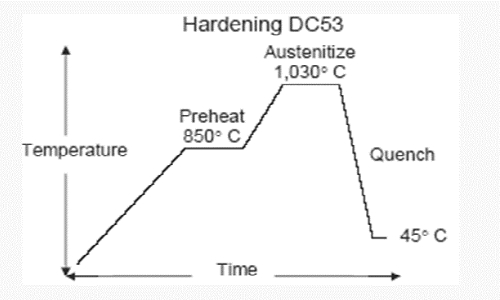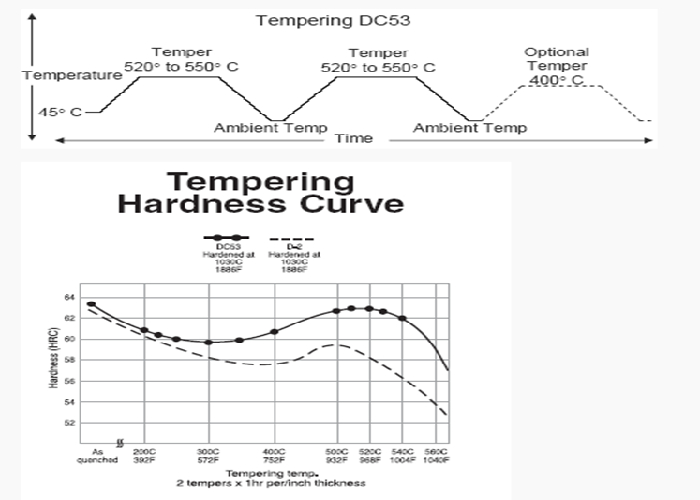(DC53)
Description
Chemical Composition
| C | Si | Mn | P | S | Cr | Mo | V |
|---|---|---|---|---|---|---|---|
| 0.96 | 1.00 | 0.28 | 0.018 | 0.002 | 8.00 | 2.10 | 0.32 |
Standards
| JIS | DIN | BOHLER | HITACHI |
|---|---|---|---|
| DC53 | 1.2990 | K340 | SLD MAGIC |
Properties
- Higher hardness (62-64 HRc) than D2 after heat treatment.
- Twice the toughness of D2 with superior wear resistance.
- Substantially higher fatigue strength compared to D2.
- Smaller primary carbides than D2 protect the die from chipping and cracking.
- Secondary refining process (DLF) reduces impurities.
- Machines and grinds up to 40% faster than D2.
- Less residual stress after wire EDMing.
Applications
- Stepped punch and press-punching dies
- Concrete sprayer parts, rotor plates
- Swaging dies and backers
- Dies for cold forging
- Thread-rolling circular dies
- Piercing punch
- Thread-rolling dies for heat-treated bolts
- Forming dies
- Stripper plates for lead frame blanking
- Gauges
- Screws for injection molding machines
- Plastic Molds

Welding: Lower minimum pre-and post – heating temperature than D2 reduces the incidence of weld cracking and simplifies welding. Low hardness decline in heat affected zone minimises any deterioration in performance.
Hardening Vacuum Furnace: Pre-heat to 300-400oC and then to 800-850oC
allowing sufficient time to equalise. Raise to 1,020-1,040oC and allow soaking time
Quenching Vacuum Furnace: The high hardenability of this steel enables it to
be satisfactorally quenched in a vacuum furnace.
Surface Treatments: Surface treatments such as CVD, PVD, TD and Nitriding require the use of relatively high processing temperatures. While this can be a problem with standard D2, the higher through hardness of DC53 steel at elevated temperatures will allow these surface treatments to be used successfully.
Tempering: Double temper according to the hardness and toughness charts below. As with D2, a third temper at 400oC should be carried out to avoid any chance of any delayed grain growth and distortion. This is the preferred heat treatment for most applications as high hardness will be the primary consideration. Where maximum toughness is required, double temper between 200 and 300oC (depending on application). Note the material tempered at the lower temperature should not be subjected to subsequent high temperature processes such as PVD.
Air Hardening: Air hardening DC53 is best accomplished under vacuum. First, preheat and hold at 800° C (1,475° F) to 850° C (1,560° F) until the part is uniformly heated and then increase the heat to 1,030° C (1,885° F) to Austenitize, otherwise known as soaking the tool. Austenitize 25 to 30 minutes per inch at temperature (to be safe, minimum austenitize time for smaller parts under 1 inch can be up to 1 hour) up to 4 inches thick in cross section and 10 to 25 minutes per inch for thickness over 4 inches before inert gas pressure quenching (Generally in nitrogen), to rapid cool with 2 times atmosphere pressure (2 bar) or high velocity equivalent. To be safe, longer times are acceptable while shorter times are not. The part should then be immediately tempered once it has reached 45° C (120° F). Be sure to check hardness at this point to assure that the part has reached the desirable hardness if at least 64 HRC.
Salt Bath Hardening – Per-heat the part to 850° C (1,550° F) until uniformly heated. Austenitize in a molten salt bath at 1,030° C (1,885° F) for a minimum of 5 minutes. See chart below for details. Salt quench and then allowed to slow cool in still air to 45° C (120° F) to 65° C to (150° F) before tempering.
| Thickness Inch (mm) | Immersion Time (Min) |
|---|---|
| 1/4" (5mm) | 5-8 |
| 1/2" (12mm) | 10-12 |
| 3/4" (20mm) | 10-15 |
| 1 1/2" (30mm) | 15-20 |
| 2" (50mm) | 20-25 |
| 4" (100mm) | 30-40 |
| Austenitize | Double High Temperature Draw |
|---|---|
| 1,030 ° C 1,885 ° F | 520 ° C HRC 62/64 968 ° F |
| 540 ° C HRC 60/62 1,004 ° F |
|
| 550 ° C HRC 58/60 1,022 ° F |
(001″ to .0015″ per inch)
An optional third temper
recommended for intricate high
precision components requiring
EDM work or PVD coatings
Tempering – Tempering is commonly performed in a non-atmosphere controlled convection furnace. The first temper should be conducted as soon as the part can be handled at about 45° C (120° F) to 65° C to (150° F). The part should be allowed to cool to ambient temperature between subsequent tempers.

